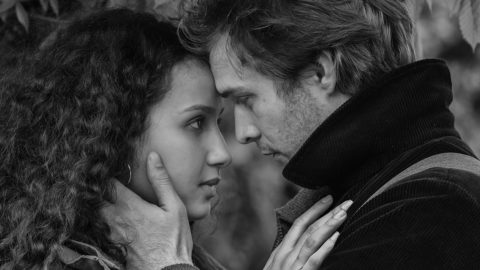Film of the Week: The Other Lamb
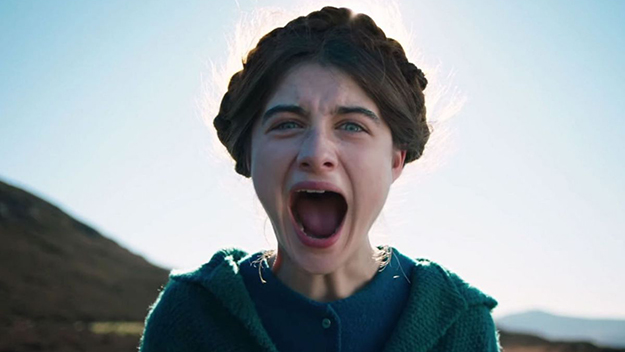
Images from The Other Lamb (Malgorzata Szumowska, 2020)
The French proto-absurdist Alfred Jarry famously set his 1896 play Ubu Roi “in Poland—in other words, nowhere.” The Other Lamb, the latest film by Polish director Malgorzata Szumowska, appears to take place anywhere but Poland. Shot in Ireland, this English-language co-production between Ireland, Belgium, and the U.S. is possibly set in present-day America—we glimpse the Stars and Stripes, and a Little League jacket—but the action seems really to happen in a landscape of the mind, a transcendental nowhere-and-nowhen particular.
Such use of an “atopian” backdrop in a film can be eerily resonant, establishing a story’s status as metaphor or pure idea above all—or it can make the viewer feel like they’re just wandering around a landscape without a map. The landscape in Szumowska’s film is beautiful and strange, and it’s certainly a visual pleasure to drift around it, but after a while, you want to know where you are, where you’re going, and how all the characters got there in the first place.
Maybe I’m being too literal, but The Other Lamb is a film that makes a point of doing away with recognizable landmarks. Characters have names, but they’re mainly borrowed from the Bible; and Szumowska films Catherine S. McMullen’s decidedly spare script in a fragmented, stop-start way that reduces narrative propulsion. What you’re left with is not so much a story as a concept presented handsomely but very frustratingly.
The concept is hardly unfamiliar. Except for a couple of supporting figures, the characters are all members of a religious community comprised of women and girls of various ages who follow the teachings of a leader known only as “Shepherd.” He’s played by Michiel Huisman with beard and flowing hair that look freshly washed in a mountain spring, ostensibly bringing Jesus comes to mind rather than Manson (although he turns out to have some of the latter’s brutish propensities). The heroine is a young flock member named Selah (Raffey Cassidy), whose stormy mien, steely gaze, and habit of climbing aloft on a mount and raging in silent screams—again and again—suggest that she’ll be the one to finally rise up and smash this particular shepherd’s patriarchal crook.
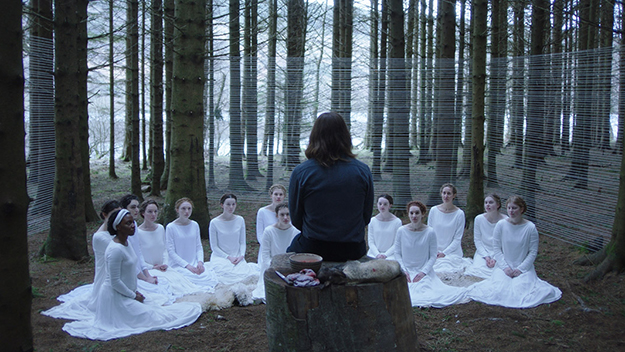
We don’t really get to know the other women in the flock, apart from one, Sarah (Denise Gough), once the Shepherd’s favored wife among many, but now relegated to marginal status, either because of misbehavior or just because she’s grown older (“Now he calls me a broken thing”). There’s some curious play with age: the older wives, now displaced by younger things, have hit middle age, while the Shepherd appears to be perpetually young, perhaps because that’s just the way the women see him. Perhaps, although it’s hard to tell; there are so many indeterminacies and enigmas, so unevenly grounded in a quasi-reality, that you have to assume that particular touches are intentional, not just odd inconsistencies.
The plot is fairly economical. For some reason, the community is moved on from their original settlement deep in a forest, and embark—accompanied by their actual flock of sheep—on a journey on foot across a seemingly endless landscape. They don’t ever seem to come close to any outside civilization: we only see the occasional road, but they prefer to trek over moors and mountains with the Shepherd leading the way, kitted out in a thick-knit jumper and sturdy rainwear, less like Jesus than Moses after a trip to Walmart’s camping department. Along the way, they all pause to sing traditional folk songs in close harmony, as in one truly misbegotten scene where they sing that Appalachian favorite “Down to the River to Pray”—and the one black woman in the congregation is seen letting rip with some gospelly soloing.
There are moments when the seemingly benign, smiling Shepherd shows his tyrannical side, selecting the wives he wants to sleep with—sometimes, just wedging his fingers into their mouth, which seems a primary fancy of his. Selah, meanwhile, listens to Sarah’s insights into the reality of life in the flock; ponders on the menstrual blood that spreads dramatically on the white dress she sometimes wears; or has furious staring contests with the flock’s ram, a mightily horned beast whose breath is amplified in the sound design to suggest a dirty phone caller with asthma.
It took me a while to work out the community’s sartorial system: the younger women and girls, some of them apparently daughters of the Shepherd, wear blue robes, while the older women, the “wives,” wear crimson, although some of the latter dresses are a little more purple. At any rate, these rough-knit garments look great in grassy or wooded landscapes alike; designed by Katarzyna Lewinska, the dresses seem to take their colors from the blues and reds of Renaissance paintings by Piero della Francesca, or Botticelli’s illustrations of Dante, and the hues seem to have been enhanced in post to give them a heightened somewhat chemical tone. There’s one shot, superbly composed by DP Michal Englert, with the women arranged on a hillside, with a river snaking off into the distance, and it looks like a pre-Raphaelite painting.
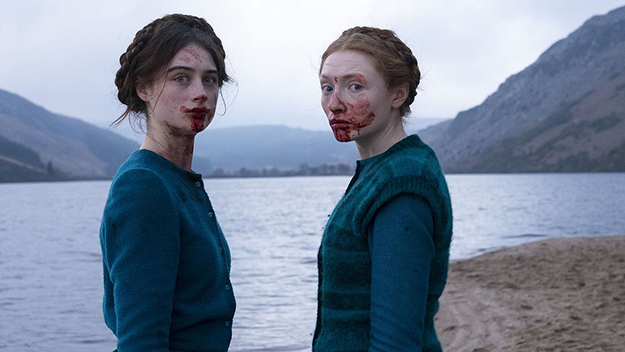
That’s the problem, though, with this exceptionally beautiful film: it’s one of those cases where you can’t see the wood for the trees, or where you can’t see the film for the pictures. At the start, you find yourself gasping at the fine images—like the repeated images of white-robed women swimming underwater in slow-motion, or the strange outdoor “church,” which consists of a fine mesh of string or wool wrapped round trees to mark off a space for worship. But after a few gasps too many, your imagination just runs out of air, and you find yourself getting distracted by mundane questions—like, how long did it take the flock to wind all those strings in perfect alignment, or are we going to find out that the Shepherd has a giant pet spider he’s been keeping out of sight?
Where the flock came from and how Selah came to be among them is a mystery—but the film is suffused with an overall sense of the enigmatic, instead of giving us any substantial enigma to engage with. As far as what it has to say about the cult—and by extension, organized religions—it’s all pretty familiar. Charismatic patriarchs are not to be trusted, and women have been made to feel bad about themselves for too long: when the Shepherd talks about “purity” and “rot,” he’s clearly decrying any sexual activity that doesn’t directly involve him, while menstruation is as big a deal here as it is in real-world religions (one woman, it’s said, “thinks the bleeding is punishment for Eve’s sin”). Menstruation, moreover, is made heavy weather of visually, rhymed with lamb’s blood and at one point, with the stripes of war paint that Selah smears on her cheeks, clearly gearing up for a showdown with the flock’s jumper-wearing big daddy.
There are also swathes of awkward dialogue—ranging from the portentously stilted (“I know you listen most ardently”) to plain clunky (“I’ve been here for so long. I don’t even know who I am any more”). And the final spoken line is so bathetic that you should prepare to splutter—although the last word, as it were, goes to a sheep, bringing things to a close with a resounding bleat.
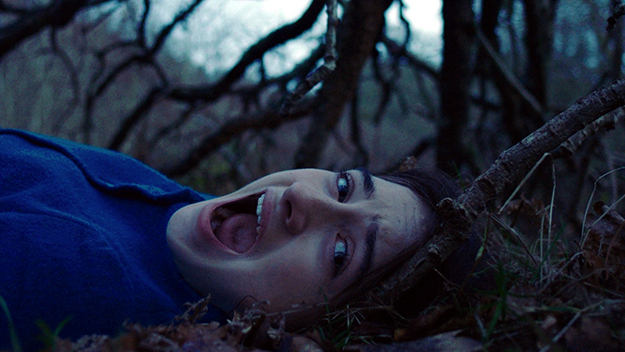
Szumowska has made a reputation on the art-house circuit as a serious-minded, ambitious director with a strong sense of visual style. I haven’t seen either Body (2015) or Mug (2018), both much praised, although 2013’s solemn In the Name of, about a gay priest, left me cold, while Paris-set drama Elles (2011) struck me as the work of a director somewhat lacking a radar for the ridiculous (if you’ve seen that film’s nude rendition of “Autumn Leaves,” you’ll know what I mean).
In The Other Lamb, Szumowska’s focus on the overwrought sublimity of the images leaves her actors a little stranded while they teeter uneasily between vaguely Irish and American accents. Denise Gough is a formidable performer, her recent stage performance in People, Places and Things nothing less than lightning in a bottle, but she doesn’t have much to do here but wear some ominous scars on her chest and play haggard and rueful. I mainly know Michiel Huisman from a convincing, saturnine performance as a rock star dabbling in country in TV’s Nashville, but here—modeling a sort of elf-warrior topknot, possibly left over from his role in Game of Thrones—he’s a little too sheepish himself, nowhere near as menacing/charismatic as the role requires. As for Raffey Cassidy—such an impressive discovery in The Killing of a Sacred Deer and Vox Lux—she has to tread water here, mainly indulging a ferocious stare that penetrates waterfalls, flame, and deep forest alike. Nevertheless she emerges pretty honorably as a figure of some presence and force, leaving you thinking two things: that you can’t wait till she gets a really substantial role that will carry a film, and wow, someone really should cast her and Daniel Radcliffe as siblings. The scene-stealer, of course, is the ram; he’s played by one “Jeffrey,” and is almost as imposing a four-legged presence as Black Philip, the satanic goat in Robert Eggers’s The Witch. He fully deserves to star in a sequel—The Other Lamb 2: Woolly Bully.
Jonathan Romney is a contributing editor to Film Comment and writes the Film of the Week column. He is a member of the London Film Critics Circle.



